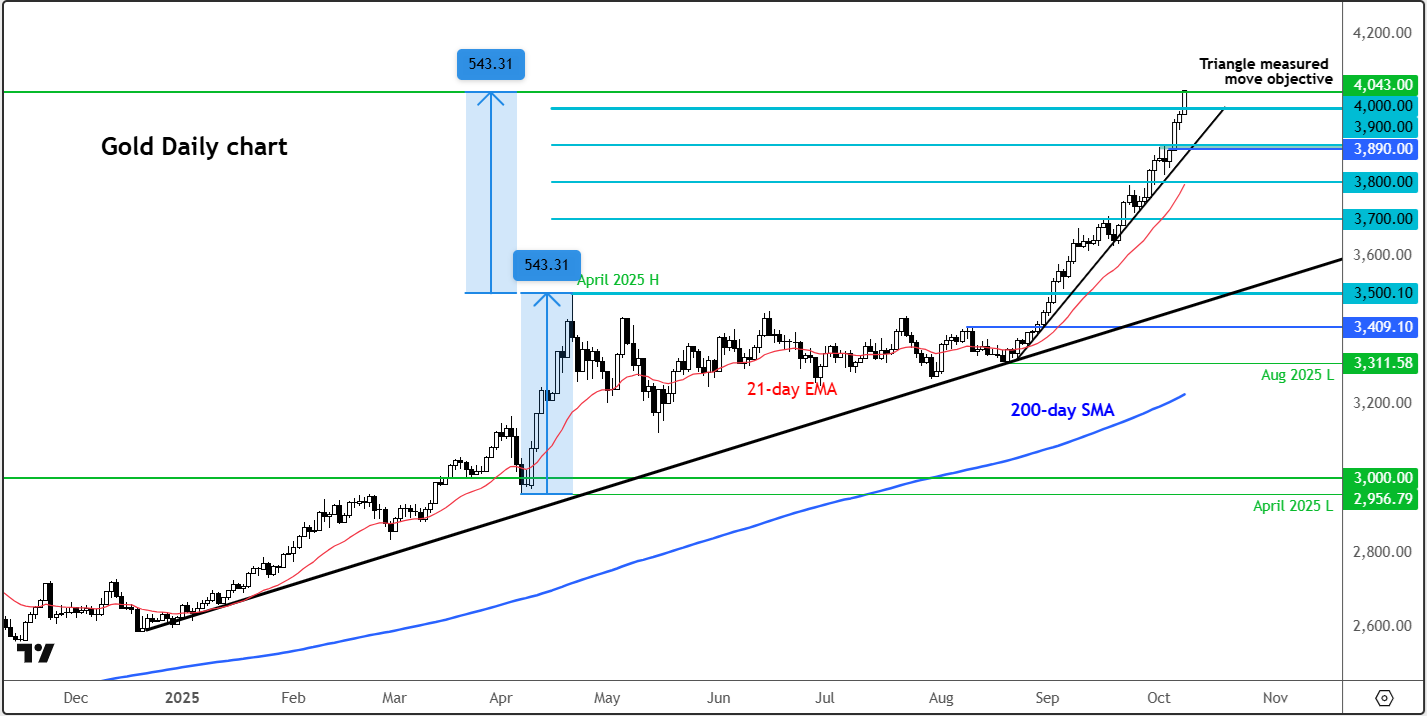Is this U.S.-China selloff a buy? A top Wall Street voice weighs in
-
Gold surges above $4,000 amid US government shutdown and global political tensions.
-
Goldman Sachs raises its 2026 target to $4,900.
-
ETF inflows, central bank buying, and Fed rate cut bets keep the bullish trend intact.
-
Looking for actionable trade ideas to navigate the current market volatility? Subscribe here to unlock access to InvestingPro’s AI-selected stock winners.
Gold is continuing to glitter, and it is a gift that keeps on giving. For the first time in history yesterday, the December gold futures broke through the $4,000-per-ounce barrier — a psychological milestone that highlights just how intense safe-haven demand has become.
Overnight, spot gold prices followed the same path, driven by a cocktail of political chaos in Washington, unrest in France, and persistent uncertainty around the global economy. Spot gold prices have since rallied another $40 to reach a new high so far of $4,040.
The key question now is: can the momentum continue, and will we see more gains? Many forecasters, like Goldman Sachs, think there’s more room to the upside for the price of gold.
Political drama adds fuel to the gold fire
Markets hate uncertainty, and right now, it’s in no short supply – although stocks haven’t exactly sold off, with the S&P 500 futures rebounding to hold near record highs. Instead, it is gold that continues to benefit from haven flows while stock markets continue to find buyers on the dips, too.
The US government shutdown has entered its second week, and there’s little sign of resolution. Another Senate vote is on the table today, but with both parties holding their ground, the odds of a breakthrough remain slim. Paychecks for government workers and military personnel are due as soon as October 10 and 15, respectively. Miss these payments, and then market anxiety could intensify.
Meanwhile, a political crisis in France is further unnerving investors, adding a European dimension to the mix. With this backdrop, gold’s surge feels more like a defensive move by traders seeking shelter from the storm. Yet, with stocks also at or near records, one can argue that much of gold buying is speculative-driven, with traders trying to front-run central banks who remain strong buyers.
Economic fog thickens, and gold prices shine brighter
Today’s release of German Industrial Production data was alarming as output fell again, but this time by a huge 4.3% month-on-month, raising recession alarm bells from the Eurozone’s sputtering economic powerhouse. Across the pond, in the US, recent macro releases have been far from convincing, especially employment. Then, there is the ongoing government shutdown.
The latter has also thrown a wrench into the release of key US economic data, including payroll figures, that were supposed to be released last week. Without fresh official data, traders are relying on private-sector reports to gauge economic health.
The Federal Reserve now faces a tougher challenge: making policy decisions in an information vacuum. Without any data, they must remain committed to what they signalled at their last meeting – that there are two more rate cuts on the way before the end of 2025.
Indeed, futures markets continue to price in a 25-basis-point Fed rate cut this month, which is helping to support the appeal of non-yielding assets like gold.
ETF inflows and central bank demand point to sustained strength
Investor appetite isn’t slowing down. Gold-backed ETFs have seen another week of robust inflows, lifting total holdings to their highest levels since September 2022. This upward trajectory suggests more room for expansion and less reason for it to drop. Something fundamentally has to change to fuel a wave of large-scale profit-taking in gold.
Indeed, on the central bank front, the People’s Bank of China has extended its buying spree for an 11th consecutive month, undeterred by record-high prices. It looks like central banks globally continue to diversify away from the US dollar and Treasuries.
Outlook remains largely bullish but with some caveats
Much of the existing drivers behind the gold rally remain in place. Whether that is geopolitical tensions, aggressive US trade policies, strong central bank accumulation, or the Fed cutting rates. That said, potential headwinds shouldn’t be ignored. A pause or reversal in central bank purchases, or a sudden easing in geopolitical tensions, could sap some of gold’s defensive allure.
But for now, momentum and macro forces are firmly aligned, which should keep bullish traders happy and in a “dip-buying” mood.
Gold technical analysis and trade ideas

With $4000 level now broken, this means a lot of bullish traders’ objectives have been met. One specific target was at $4043 area, marking the measured move objective from the triangle breakout, as shown on the chart. But unless gold forms a clear reversal top pattern, dip buyers will be lurking around for more opportunities, especially as gold prices have not just broken this psychological $4K barrier, but have surged right through it.
The next upside objectives include round handles like $4,100, $4,200, and so on. On the downside, initial support now comes in at $4K, followed by the trend line and then $3900.
****
InvestingPro provides a comprehensive suite of tools designed to help investors make informed decisions in any market environment. These include:
- AI-managed stock market strategies re-evaluated monthly.
- 10 years of historical financial data for thousands of global stocks.
- A database of investor, billionaire, and hedge fund positions.
- And many other tools that help tens of thousands of investors outperform the market every day!
Not a Pro member yet? Check out our plans here.
Disclaimer: This article is written for informational purposes only; it does not constitute a solicitation, offer, advice, counsel or recommendation to invest as such it is not intended to incentivize the purchase of assets in any way. I would like to remind you that any type of asset, is evaluated from multiple perspectives and is highly risky and therefore, any investment decision and the associated risk remains with the investor.
